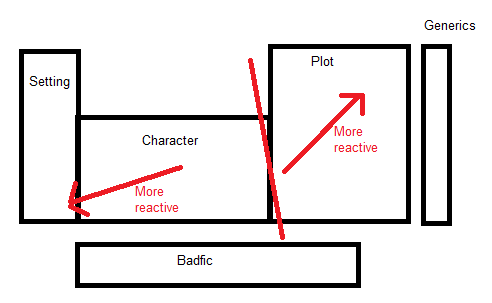Subject: Well, someone with a knowledge of tropes.
Author:
Posted on: 2014-02-20 09:58:00 UTC
I suspect that would be more useful than chemistry at this stage.
But... eh, let's at least outline. Ignoring the proton count (because it doesn't apply here), we have three or four criteria for laying out the table:
-Electronegativity, or rather reactivity. This increases towards the top right and bottom left corners (specifically, e-neg increases to top right, but e-pos increases towards bottom left). The exception is the noble gases, which are virtually zero.
Reactivity would seem to correlate with how popular a concept is, or rather, how well it meshes with others. No, rather, I think it's how prone it is to taking over the story. To take a chemistry analogy, if you add potassium to sodium chloride solution, the more reactive potassium will drive out the sodium.
-Group, or column. These group elements which are similar in some way - and also, which can easily replace each other. So in each column you'd have a set of elements which can be interchanged, in order of their ability to dominate the story.
Related to this is the electron count, which in our case is 'elements they go well with'. Group VII elements, for instance, will go very nicely with Group I elements - but need extra work to compound with Group II. So, for instance, songfic-Mary Sue is a simple compound that clearly works easily, while CYOA-Mary Sue is more difficult, and requires more to work.
-Block, or maybe element type. There are four 'blocks' on the Periodic Table: the s-block of reactive metals, the p-block of (mostly) non-metals, the d-block of metals, and the f-block of unstable elements (this is a simplification, naturally). Someone already suggested putting the pure-badfic elements at the bottom, which is the f-block. Then I guess we'd split into cast/plot, and further divide cast into setting and characters.
The main thing that needs to be done to keep it analogous is making sure that the first and second columns from the left and right work well together - that is, that aspects of plot that are affected by setting are in the last two columns of the plot-block.
(For fun, the blocks should of course be Setting, Plot, Demographic, and wtF, to match their real names)
The generics are things like Generic Foodstuff, Generic Surface (Generic Ability to Not Go To The Toilet?), which appear virtually everywhere, but have no impact on everything.
hS
